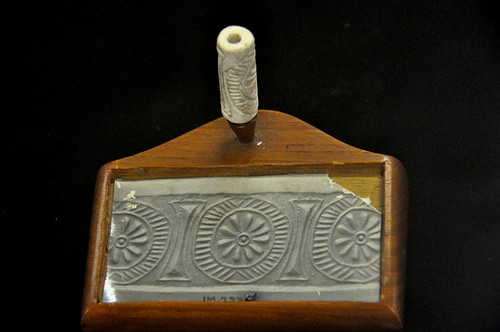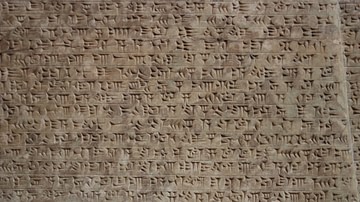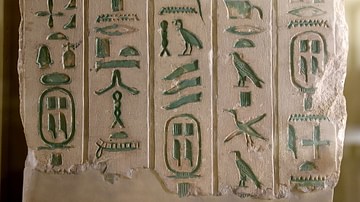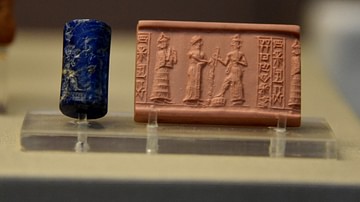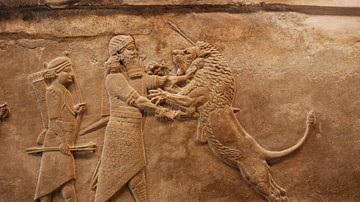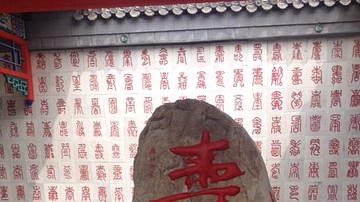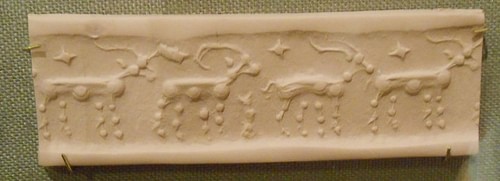
Cylinder Seals were impression stamps used by the people of ancient Mesopotamia. Known as kishib in Sumerian and kunukku in Akkadian, the seals were used by everyone, from royals to slaves, as a means of authenticating identity in correspondence. In time, they came to be recognized as one's personal identification.
They originated in the Late Neolithic Period c. 7600-6000 BCE in the region known today as Syria (though, according to other claims, they originated later in Sumeria, modern Iraq) and were made from semiprecious stone (marble, obsidian, amethyst, lapis lazuli, to name only some) or metal (gold or silver). These seals were worn by their owners on strings of leather or other material around the neck or wrist or pinned to a garment.
The purpose of seals was to serve as a personal signature on a document or package to guarantee authenticity or legitimize a business deal; in the same way one signs a letter or form today or writes one's return address on an envelope or package to be mailed. The seal was rolled onto the moist clay of the document as an offical, binding, signature. Cylinder seals were also used in Egypt and developed completely independently in Mesoamerica as evidenced by archaeological finds of Olmec cylinder seals dating to c. 650 BCE. The Mesopotamian cylinder seal is the best known, however, and was the most widely used.
Cylinder Seals & Stamp Seals
Contemporaneous with cylinder seals were stamp seals which were smaller and less ornate in design. The typical cylinder seal was between 3-4 inches (7-10 cm) long while stamp seals were less than an inch (2 cm) in total and more closely resembled the later signet ring. It would make sense that the stamp seals preceded the cylinder seals as the former are more rudimentary but evidence suggests the seals were in use at the same time with one type favored more than the other in different regions. Scholar Clemens Reichel (whose essay is included in Englehardt's work, Agency in Ancient Writing) suggests the reason for this was simply a matter of necessity.
Those areas which favored the stamp seal (the regions of modern-day Syria and Turkey) had no need for the elaborate design imprint of the cylinder seal while the regions to the south, which had a more highly developed bureaucracy, required more detailed information in a seal.
The city of Uruk, for example, had a highly complex bureaucracy of different agencies which required detailed information on who was signing what document and, further, which office it originated from. The simpler and smaller stamp seals could not provide the space on which to carve such information while the longer cylinder seals fit the need perfectly.
The longer cylinder seals would have provided the name of the agency and name and title of the individual within that agency who was signing the document. In order to accurately represent and identify the owner of such a seal, a skilled artist was required who carved the story of the individual on the stone cylinder in exacting detail.
Manufacture of Seals
Cylinder seals were made by a sealcutter known as a burgul in Sumerian and as a purkullu in the Akkadian language. Young sealcutters, probably males, apprenticed with a master sealcutter for at least four years before setting up their own shop as a professional.
The seal-makers tools consisted of copper chisels and gravers, a whetsone, a borer, and saws for cutting through stone. Scholar Stephen Bertman claims that "rather than cutting rough cylinders from stone, the sealcutters may have bought blanks from dealers, adding the finishing touches in their workshops" (233). Once the seal was carved, or perhaps before work was begun on the blank, holes were drilled into the cylinder so that the owner could wear it on a string or pin it to a garment.
The seals were carved in intaglio, a process of carving beneath the surface of the stone so an impression of that carving creates an image in relief (what one would know today as a `photographic reverse' or a negative). In order to achieve this effect, the artist would have had to reverse the image he wanted to create as he worked. This required enormous skill and sealcutters were highly paid and greatly respected for their craft.
Styles & Uses of Seals
The two styles of seals are the Uruk-Style and the Jemdet Nasr-Style which refer to the motifs used and the way the seals were carved. Authors Megan Lewis & Marian Feldman note their differences:
The Uruk-style seals show animals and figures depicted in an exceptionally naturalistic fashion, suggesting that the seal carvers were aiming for expressive clarity. The motifs include ritual narratives involving temples, boats and offerings to gods, as well as depictions of the natural world in hierarchical arrangements. They are skillfully cut, detailed, and their composition tends to be balanced and aesthetically pleasing. The Jemdet Nasr-style seals are less detailed than Uruk-style seals and are characterized by the heavy use of drills and cutting discs, which produce round and linear marks respectively. Common motifs from the Jemdet Nasr-style include women with pigtails involved in domestic labor and herds of animals in front of temples. (4)
The uses of the seals were both practical and spiritual. Lewis and Feldman note the practical uses of signing one's name, restricting access only to those allowed to break the seal, and as a means of personal identification. The spiritual use was `amuletic', which refers to the Mesopotamian belief in the seal as an amulet, a kind of charm, which could ward off evil spirits and protect one from harm or bring one luck.
The seal of a ruler, of course, demonstrated that individual's strength and ability to govern. The Mesopotamians saw their existence as a cooperative venture with the gods to maintain order and hold back the primordial forces of chaos. The king, as intermediary between the people and the gods, would have to be exceptionally adept at this kind of balance.
In a famous seal from the region of Persia, an unknown king controls chaos as symbolized by the two griffin-like creatures on either side of him. The monarch stands at the center of this seal's story, stately and in control, while he holds the creatures by their manes, keeping chaos in check and maintaining order. The identity of the king is signified by the symbols on the left of the central image. This particular seal would have been used by the ruler in signing all decrees and pronouncements and, everytime anyone saw it, they would be reminded of that king's stature.
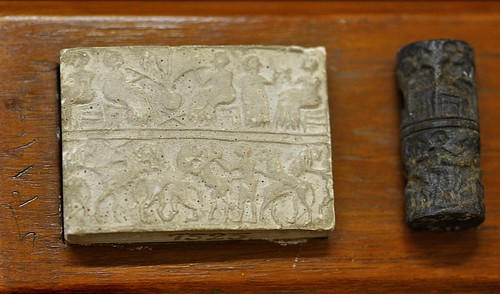
Regardless of what purpose it was put to, the seal was a prized possession and its loss was taken as seriously as people today regard the loss of their personal ID or credit cards. Bertman writes how, if someone lost their seal, "the former owner would record the date and time of loss with an official to insure that transactions made after the loss would be invalid" (235). Since the seals conveyed one's occupation, official position, and even one's name, the loss was significant.
One's personal identity was made clear either by the likeness engraved on the seal or by symbols surrounding an image. For example, if one were a weaver one's occupation would be symbolized by a spider (which weaves a web) and symbols around the spider image would give the individual's name. The loss would have been as serious to an ancient Mesopotamian as the danger of "identity theft" is in the modern day as one's seal not only served as personal identification but as a symbol of one's authority and position in society.
Conclusion
The cylinder seal was used for all correspondence and for business transations requiring an official signature in order to be considered valid. Land deals, marriage contracts, sales of goods, royal decrees, and religious declarations all required the personal signature of the presiding official or participants involved.
Historians and scholars, especially art historians, have long appreciated the significance of the seals for their beauty and craftsmanship but also for the story they tell of the past. The cylinder seal is a snapshot of the period in which is was made and of the individual who used it and, as such, is an intimate glimpse into the daily life of the ancient Mesopotamians.
